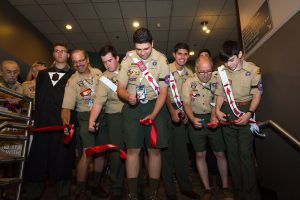Using photography to develop a local OA history is important. Images are a well-known resource and an under-appreciated asset. The written record provides the core facts and information about a Lodge’s history. Supplementing that record with a photographic record provides perspective and presence.
There should be two separate goals to add photography to your Lodge history. The first is to research and acquire photographs from the past. The second goal is to begin creating contemporary photographs to serve future Lodge historians of the future.
Photographs From The Past

It is likely your Lodge already has some photography to start with. Long-time lodge members or their families likely possess them in their homes. If you know members who own these images, you can either ask for a donation, or ask for the opportunity to scan them so the Lodge has a copy.
You have hit the jackpot If you locate images that are still available in slides or negatives. Scanning your slides or negatives will result in superior images. Access to a film scanner will come in handy, but you can also look up a local shop who will do the scanning for you for a fee. Save your scans at least 300dpi and in TIF format. Jpegs are popular lossy formats, and there is a significant loss in quality. If you want to someday print an image in a large size, having the highest quality will be very important.
Prints are also acceptable, but you will likely run into issues with damaged paper, fading paper, low quality prints, and other issues. Older images tend to age better. Higher quality paper was used in the early days of photography.
The 1970s in particular are notorious for the low quality of their prints. Most prints from this period are low quality and fading/yellowing on mediocre paper. Those images will need serious restoration work from an experienced Photoshop artist. Many photo businesses offer restoration services but they do charge a hefty fee.
Contemporary Photography

Every day, history is made. It is very important to keep a photographic record for those in the future to enjoy. Collecting images from the past should provide clues about what is important to your Lodge.
What parts of your Lodge’s history did you find photographs? What parts of your Lodge’s history are missing images? What historical moments would you have loved to seen an image? Write those down and compare to what your Lodge is doing today, and you will have an excellent starter list.

Events are a great way to start. As you track past events in your Lodge’s history, you will see that recording your current events are important. Capturing Lodge leaders, key guests, and Arrowmen in action are a great start to a great photographic history. Supplement your images with names and the subject matter, so future people will know who is who.
Candid photographs are best. While it is easy to make an image of Lodge leaders standing together, why not capture them in action, whether it be an Ordeal, a fellowship, or a banquet?
Plan your images. Make a list of the images you want from an event and capture them. You will be ready when significant unexpected moments come up.
Equipment is not everything. Everybody would love to have a professional DSLR, a speedlight, and other fancy equipment, but the best camera in the world is the one you have in your hand. In good light, even a cell phone can make a great image.
Organizing The Images
Now that you have built a historical collection of photographs, and you have a plan for making future images, now you need to do something with them.
Hosting the images on your Lodge website is a good start, but you can also use services like Flickr. Be wary of social media sites. They are a good place to upload images copies for many members to see, but those services frequently compress and alter your images to save storage space. They will not be the same quality as your originals.
Where possible, it is important to save the original RAW files if you taken by an SLR. You may consider also saving in Adobe’s DNG format to help future-proof your raw files.
In addition, you need to go beyond simply posting photographs. Photographs should be searchable and include additional metadata. The most important task is to “keyword” your images with descriptive items that make the images searchable by a variety of areas.
Categorizing your images by a variety areas will help you show your images. Categories can include events, years, decades or eras, or other descriptive information.
With a plan to acquire older images and create new images while building your Lodge’s local history, photography can be a huge resource to making a resource for your Lodge members and future members to enjoy.
Order of the Arrow Pages
- ArrowCorps5 Manti-La Sal Archive
- California’s First Vigil Honor Recipient
- Conclave Theory – Promotions
- Creating A Historical Archive
- Happy 20th Birthday Snakepower.org
- How Demographic Changes Affect The Program
- I Was Never Nominated For The Vigil Honor
- Lodge Historians – What To Do With Photography
- OA Collecting
- Arrowhead Patches
- Bullion Patches
- California Neckerchiefs
- California OA Collecting
- Camp Patches and Collectibles
- Chenilles
- Jacket Patches
- Leather Patches
- Non-OA Society Patches
- OA CSPs
- OA Multi-Piece Patch Sets
- OA Neckerchiefs
- OA Odd Shapes
- OA Round Patches
- Patches I Owe Bill For
- Patches I Owe Nick For
- Patches I Owe Thom For
- Pocket Flaps
- Rounds
- OA Pocket Flap Bait And Switch
- Order of the Arrow Pages Background
- Photography’s Role In Developing OA History
- Pre-OA Societies In The Inland Empire
- Rethinking Chapters
- Thank You
- You Are Doing Social Media Wrong
